Two Almond Cultivars Trained in a Super-High Density Orchard Show Different Growth, Yield Efficiencies and Damages by Mechanical Harvesting
Abstract
:1. Introduction
2. Materials and Methods
2.1. Site and Orchard
2.2. Climate Data
2.3. Sampling
2.4. Growth
2.5. Yield and Yield Efficiencies
2.6. Harvesting Efficiency and Damaged Axes
2.7. Fruits Quality Parameters
2.8. Data Analysis
2.9. Weather Data
3. Results
3.1. Growth
3.2. Yield and Other Growth Parameters
3.3. Yield Efficiencies
3.4. Harvesting Efficiency and Damaged Axes
3.5. Quality Parameters
4. Discussion
5. Conclusions
Author Contributions
Funding
Institutional Review Board Statement
Informed Consent Statement
Data Availability Statement
Acknowledgments
Conflicts of Interest
References
- Nuts and Dried Fruits Statistical Yearbook 2019/2020. Available online: https://www.nutfruit.org/files/tech/1587539172_INC_Statistical_Yearbook_2019-2020.pdf (accessed on 2 July 2021).
- Food and Agriculture Organization of the United Nations—FAOSTAT. Available online: http://www.fao.org/faostat/en/#home (accessed on 2 July 2021).
- Global Almond Market 2019—After Five Years of Robust Growth of In-Shell Nut Imports, India Emerges at the Most Promising Market. Available online: https://www.globaltrademag.com/global-almond-market-2019-after-five-years-of-robust-growth-of-in-shell-nut-imports-india-emerges-as-the-most-promising-market (accessed on 2 July 2021).
- Iglesias, I. Costes de producción, sistemas de formación y mecanización en frutales, con especial referencia al melocotonero. Rev. Frutic. 2019, 69, 50–59. [Google Scholar]
- Iglesias, I.; Foles, P.; Oliveira, C. El cultivo del almendro en España y Portugal: Situación, innovación tecnológica, costes, rentabilidad y perspectivas. Rev. Frutic. 2021, 81, 6–49. [Google Scholar]
- Felipe, A.J.; Rius, X.; Rubio-Cabetas, M.J. El Cultivo Del Almendro (El Almendro II), 1st ed.; Calidad Gràfica araconsa S.L.: Zaragoza, Spain, 2017; ISBN 978-0-646-97816-1. [Google Scholar]
- Sottile, F.; Barone, E.; Barbera, G.; Palasciano, M. The Italian almond industry: New perspectives and ancient tradition. Acta Hortic. 2014, 1028, 401–406. [Google Scholar] [CrossRef] [Green Version]
- Expósito, A.; Berbel, J. The Economics of Irrigation in Almond Orchards. Application to Southern Spain. Agronomy 2020, 10, 796. [Google Scholar] [CrossRef]
- Caruso, T.; Campisi, G.; Marra, F.P.; Camposeo, S.; Vivaldi, G.A.; Proietti, P.; Nasini, L. Growth and yields of the cultivar Arbequina in high density planting systems in three different olive growing areas in Italy. Acta Hortic. 2014, 1057, 341–348. [Google Scholar] [CrossRef] [Green Version]
- Camposeo, S.; Vivaldi, G.A.; Gattullo, C.E. Ripening indices and harvesting times of different olive cultivars for continuous harvest. Sci. Hortic. 2013, 151, 1–10. [Google Scholar] [CrossRef]
- Vivaldi, G.A.; Strippoli, G.; Pascuzzi, S.; Stellacci, A.M.; Camposeo, S. Olive genotypes cultivated in an adult high-density orchard respond differently to canopy restraining by mechanical and manual pruning. Sci. Hortic. 2015, 192, 391–399. [Google Scholar] [CrossRef]
- Camposeo, S.; Vivaldi, G.A. Yield, harvesting efficiency and oil chemical quality of cultivars Arbequina and Arbosana harvested by straddle machine in two Apulian growing areas. Acta Hortic. 2018, 1199, 397–402. [Google Scholar] [CrossRef]
- Connor, D.J.; Goméz-del-Campo, M.; Rousseaux, M.C.; Searles, P.S. Structure, management and productivity of hedgerow olive orchards: A review. Sci. Hortic. 2014, 169, 71–93. [Google Scholar] [CrossRef]
- Pellegrini, G.; La Sala, P.; Camposeo, S.; Contò, F. Economic sustainability of the oil high and super-high density cropping systems in Italy. Glob. Bus. Econ. Rev. 2017, 19, 553–569. [Google Scholar] [CrossRef]
- Pellegrini, G.; Ingrao, C.; Camposeo, S.; Tricase, C.; Contò, F.; Huisingh, D. Application of Water Footprint to olive growing systems in the Apulia region: A comparative assessment. J. Clean. Prod. 2016, 112, 2407–2418. [Google Scholar] [CrossRef]
- Agromillora–SHD Almond Crops. Available online: https://www.agromillora.com/shd-almond-crops/ (accessed on 2 July 2021).
- Roca, J.M.; Gòmez, J.M.; Lòpez, M. El almendro en seto SHD. La recolecciòn con màquinas cabalgantes. Olint 2014, 25, 35–45. [Google Scholar]
- Rodas, A. SHD en el mundo. Paìses con presencia de plantaciones en sistema superintensivo de almendro. Olint 2015, 28, 24–25. [Google Scholar]
- Álvarez, S.; Martín, H.; Barajas, E.; Rubio, J.A.; Vivaldi, G.A. Rootstock Effects on Water Relations of Young Almond Trees (cv. Soleta) When Subjected to Water Stress and Rehydration. Water 2020, 12, 3319. [Google Scholar] [CrossRef]
- Casanova-Gascòn, J.; Figueras-Panillo, M.; Iglesias-Castellarnau, J.; Martin-Ramos, P. Comparison of SHD and Open-Center Training Systems in Almond Tree Orchards cv. “Soleta”. Agronomy 2019, 9, 874. [Google Scholar] [CrossRef] [Green Version]
- Iglesias, I.; Torrents, J. Diseño de nuevas plantaciones adaptadas a la mecanización en frutales. Horticultura 2020, 346, 60–67. [Google Scholar]
- Maldera, F.; Vivaldi, G.A.; Iglesias-Castellarnau, I.; Camposeo, S. Row Orientation and Canopy Position Affect Bud Differentiation, Leaf Area Index and Some Agronomical Traits of a Super High-Density Almond Orchard. Agronomy 2021, 11, 251. [Google Scholar] [CrossRef]
- Ben Yahmed, J.; Ghrab, M.; Ben Mimoun, M. Eco-physiological evaluation of different scion-rootstock combinations of almond grown in Mediterranean conditions. Fruits 2016, 71, 185–193. [Google Scholar] [CrossRef] [Green Version]
- Garnett, T.; Appleby, M.C.; Balmford, A.; Bateman, I.J.; Benton, T.G.; Bloomer, P.; Burlingame, B.; Dawkins, M.; Dolan, L.; Fraser, D.; et al. Sustainable intensification in agriculture: Premises and policies. Science 2013, 341, 33–34. [Google Scholar] [CrossRef]
- Charles, H.; Godfray, H.; Garnett, T. Food security and sustainable intensification. Philos. Trans. R. Soc. B 2014, 369. [Google Scholar] [CrossRef]
- Petersen, B.; Snapp, S. What is sustainable intensification? Views from experts. Land Use Policy 2015, 46, 1–10. [Google Scholar] [CrossRef]
- Willett, W.; Rockström, J.; Loken, B.; Springmann, M.; Lang, T.; Vermeulen, S.; Garnett, T.; Tilman, D.; de Clerck, F.; Wood, A.; et al. Food in the Anthropocene: The EAT-Lancet Commission on healthy diets from sustainable food systems. Lancet 2019, 393, 447–492. [Google Scholar] [CrossRef]
- Robinson, T.L.; Andersen, R.L.; Hoying, S.A. Performance of Gisela® rootstocks in six high density sweet cherry training systems in the northeastern United States. Acta Hortic. 2008, 795 Pt 1, 245–253. [Google Scholar] [CrossRef]
- Robinson, T.L.; Lakso, A.N.; Carpenter, S.G. Canopy Development, Yield, and Fruit Quality of ‘Empire’ and ‘Delicious’ Apple Trees Grown in Four Orchard Production Systems for Ten Years. J. Am. Soc. Hortic. Sci. 1991, 116, 179–187. [Google Scholar] [CrossRef] [Green Version]
- Reig, G.; Lordan, J.; Miranda Sazo, M.; Hoying, S.; Fargione, M.; Reginato, G.; Donahue, D.J.; Francescatto, P.; Fazio, G.; Robinson, T. Long-term performance of ‘Gala’ Fuji’ and ‘Honeycrisp’ apple trees grafted on Geneva® rootstocks and trained to four production systems under New York State climatic conditions. Sci. Hortic. 2019, 244, 277–293. [Google Scholar] [CrossRef]
- Reig, G.; Lordan, J.; Miranda Sazo, M.; Hoying, S.A.; Fargione, M.J.; Hernan Reginato, G.; Donahue, D.J.; Francescatto, P.; Fazio, G.; Robinson, T.L. Effect of tree type and rootstock on the long-term performance of ‘Gala’, ‘Fuji’ and ‘Honeycrisp’ apple trees trained to Tall Spindle under New York State climatic conditions. Sci. Hortic. 2019, 246, 506–517. [Google Scholar] [CrossRef]
- Sansavini, S.; Corelli-Grappadelli, L. Yield and light efficiency for high quality fruit in apple and peach high density planting. Acta Hortic. 1997, 451, 559–568. [Google Scholar] [CrossRef]
- Fioravanço, J.C.; Czermainski, A.B.C.; de Oliveira, P.R.D. Yield efficiency for nine apple cultivars grafted on two rootstocks. Cienc. Rural 2016, 46, 1701–1706. [Google Scholar] [CrossRef] [Green Version]
- Iglesias, I. La intensificación sostenible como respuesta al Pacto Verde de la Unión Europea: Retos y ejemplos en la producción agrícola y el consumo alimentario. Rev. Frutic. 2021, 79, 45–57. [Google Scholar]
- Arquero, O.; Lovera, M.; Salguero, A.; Morales, J.; Navarro, A.; General, D.; Agraria, D.I.; de Andalucía, J. Tree growth descriptors of main late-flowering almond varieties in the Mediterranean basin. Options Mediterr. 2005, 74, 71–74. [Google Scholar]
- Duval, H.; Grasselly, C. Behaviour of Some Self-Fertile Almond Selections in the Southeast of France. Acta hortic 1994, 373, 69–74. [Google Scholar] [CrossRef]
- Kaska, N.; Ozcan, Z.; Ak, B.E. Recent developments of almond culture in the southeast Anatolia region of Turkey. Options Méditerr. 2005, 63, 225–231. [Google Scholar]
- Barbera, G.; Schirra, M. Effects of rootstock on productive and tow almond cultivars. Acta Hortic. 1994, 373, 129–134. [Google Scholar] [CrossRef]
- Gutiérrez-Gordillo, S.; García-Tejero, I.F.; García-Escalera, A.; Galindo, P.; Arco, M.D.C.; Zuazo, V.H.D. Approach to yield response of young almond trees to deficit irrigation and biostimulant applications. Horticulturae 2019, 5, 38. [Google Scholar] [CrossRef] [Green Version]
- Oukabli, A.; Mamouni, A.; Lahlou, M. Behaviour of some self-compatible almond selections in the Mediterranean south sea side (Morocco). Options Méditerr. 2005, 63, 153–158. [Google Scholar]
- Lovicu, G.; Pala, M.; de Pau, L.; Satta, D.; Farci, M. Bioagronomical behaviour of some almond cultivars in Sardinia. Acta Hortic. 2001, 591, 487–491. [Google Scholar] [CrossRef]
- Hammami, S.; Mimoun, M.B. New challenges in olive orchard management. Available online: https://www.researchgate.net/profile/Mehdi-Ben-Mimoun/publication/315448526_New_challenges_in_olive_orchard_management/links/58e12ef1a6fdcc41bf944b44/New-challenges-in-olive-orchard-management.pdf (accessed on 2 July 2021).
- Morales-Sillero, A.; Rallo, P.; Jiménez, M.R.; Casanova, L.; Suárez, M.P. Suitability of two table olive cultivars (“manzanilla de sevilla” and ’manzanilla cacereña’) for mechanical harvesting in superhigh-density hedgerows. HortScience 2014, 49, 1028–1033. [Google Scholar] [CrossRef]
- Pérez-Ruiz, M.; Rallo, P.; Jiménez, M.R.; Garrido-Izard, M.; Suárez, M.P.; Casanova, L.; Valero, C.; Martínez-Guanter, J.; Morales-Sillero, A. Evaluation of over-the-row harvester damage in a super-high-density olive orchard using on-board sensing techniques. Sensors 2018, 18, 1242. [Google Scholar] [CrossRef] [Green Version]
- Tous, J. Olive production systems and mechanization. Acta Hortic. 2011, 924, 169–184. [Google Scholar] [CrossRef]
- Sola-Guirado, R.R.; Aragon-Rodriguez, F.; Castro-Garcia, S.; Gil-Ribes, J. The vibration behaviour of hedgerow olive trees in response to mechanical harvesting with straddle harvester. Biosyst. Eng. 2019, 184, 81–89. [Google Scholar] [CrossRef]
- Loghavi, M.; Khorsandi, F.; Souri, S. The effects of shaking frequency and amplitude on vibratory harvesting of almond (Prunus dulcis L. cv. 7Shahrood). ASABE 2011, 3, 2466–2472. [Google Scholar] [CrossRef]
- Tous, J.; Romero, A.; Hermoso, J.F.; Msallem, M.; Larbi, A. Olive orchard design and mechanization: Present and future. Acta Hortic. 2014, 1057, 231–246. [Google Scholar] [CrossRef]
- Lodolini, E.M.; Polverigiani, S.; Sirugo, M.; Neri, D. Damage to several olive cultivars by two over-the-row harvesters in high-density orchards. Acta Hortic. 2018, 1199, 415–419. [Google Scholar] [CrossRef]
- Iglesias, I.; Echeverría, G.; Soria, Y. Differences in fruit colour development, anthocyanin content, fruit quality and sensory acceptability of eight ‘Gala’ apple strains. Sci. Hortic. 2008, 119, 32–40. [Google Scholar] [CrossRef]
- Iglesias, I.; Echeverría, G. Overview of peach industry in the European Union with special reference to Spain. Acta Hortic. 2021, 1304, 163–176. [Google Scholar] [CrossRef]
- Sánchez-Pérez, R.; Ortega, E.; Duval, H.; Martínez-Gómez, P.; Dicenta, F. Inheritance and relationships of important agronomic traits in almond. Euphytica 2007, 155, 381–391. [Google Scholar] [CrossRef]
- Dicenta, F.; García, J.E. Inheritance of self-compatibility in almond. Heredity 1993, 70, 313–317. [Google Scholar] [CrossRef]
- Kester, D.E.; Hansche, P.E.; Beres, V.; Asay, R.N. Variance components and heritability of nut and kernel traits in almond. J. Am. Soc. Hortic Sci. 1977, 102, 264–266. [Google Scholar]
- Socias, R.; Kodad, O.; Alonso, J.M.; Gradziel, T.M. Almond quality: A breeding perspective. Hortic. Rev. 2007, 34, 197–238. [Google Scholar]
- Kester, D.; Micke, W.C.; Rough, D.; Morrison, D.; Curtis, R. Almond variety evaluation. Calif. Agric. 1980, 34, 4–7. [Google Scholar]
- EGEA, J.; Burgos, L. Double kerneled fruits in almond (Prunus dulcis Mill.) as related to pre-blossom temperatures. Ann. Appl. Biol. 1995, 126, 163–168. [Google Scholar] [CrossRef]
- Rikhter, A.A. Ways and methods of almond breeding. Tr Gos Nikit Bot Sad 1974, 43, 81–94. [Google Scholar]
- Spiegel-Roy, P.; Kochba, J. The inheritance of bitter and double kernel characters in the almond. Z. Pflanz. 1974, 71, 319–329. [Google Scholar]
- Palasciano, M.; Godini, A.; de Palma, L. Optimized self-pollination and production of double kernel in almond. Acta Hortic. 1993, 373, 215–218. [Google Scholar] [CrossRef]
- Sakar, E.H.; El Yamani, M.; Boussakouran, A.; Rharrabti, Y. Codification and description of almond (Prunus dulcis) vegetative and reproductive phenology according to the extended BBCH scale. Sci. Hortic. 2019, 247, 224–234. [Google Scholar] [CrossRef]
- Dias, A.B.; Caeiro, L.; Félix, G.; Falcao, J.M. Evaluation of biometric parameters of ‘Belona’, ‘Guara’ and ‘Lauranne’ cultivars in a superhigh density orchard. Acta Hortic. 2018, 1219. [Google Scholar] [CrossRef] [Green Version]
- Dicenta, F.; Sànchez-Pèrez, R.; Rubio, M.; Egea, J.; Battle, I.; Miarnau, X.; Palasciano, M.; Lipari, E.; Confolent, C.; Martìnez-Gòmez, P.; et al. The origin of the self-compatible almond ‘Guara’. Sci. Hortic. 2015, 197, 1–4. [Google Scholar] [CrossRef]
- Felipe, A.J. On the origin of “Guara” almond. FAO-CIHEAM Nucis-Newsl. 2017, 17, 16–18. [Google Scholar]
- Legave, J.M.; Richard, J.C.; Thermoz, J.P.; Duval, H. Lauranne Avijor dans la course. Fruits Légumes 1997, 155, 36–38. [Google Scholar]
- Grasselly, C.; Olivier, G.; Niboucha, A. Le caractère autocompatibilité de l’Amandier dans le programme de 1’I.N.R.A. In Proceedings of the 8th Colloque du Programme de Recherche Agrimed, Amélioration Génétique de deux Espèces de Fruits secs Méditerranéens: L’amandier et le Pistachier, Nîmes, France, 26–27 June 1990; pp. 9–17, ISBN 92-826-4878-8. [Google Scholar]
- Monastra, F.; Martelli, G.; Chiarotti, A. Economic advantages of high-density planting of almond orchards. Options Méditerr. 1998, 85, 81–85. [Google Scholar]
- Dicenta, F.; García, J.E. Inheritance of the kernel flavour in almond. Heredity 1993, 70, 308–312. [Google Scholar] [CrossRef] [Green Version]
- Arteaga, N.; Socias i Company, R. Heritability of fruit and kernel traits in almond. Acta Hortic. 2002, 591, 269–274. [Google Scholar] [CrossRef]
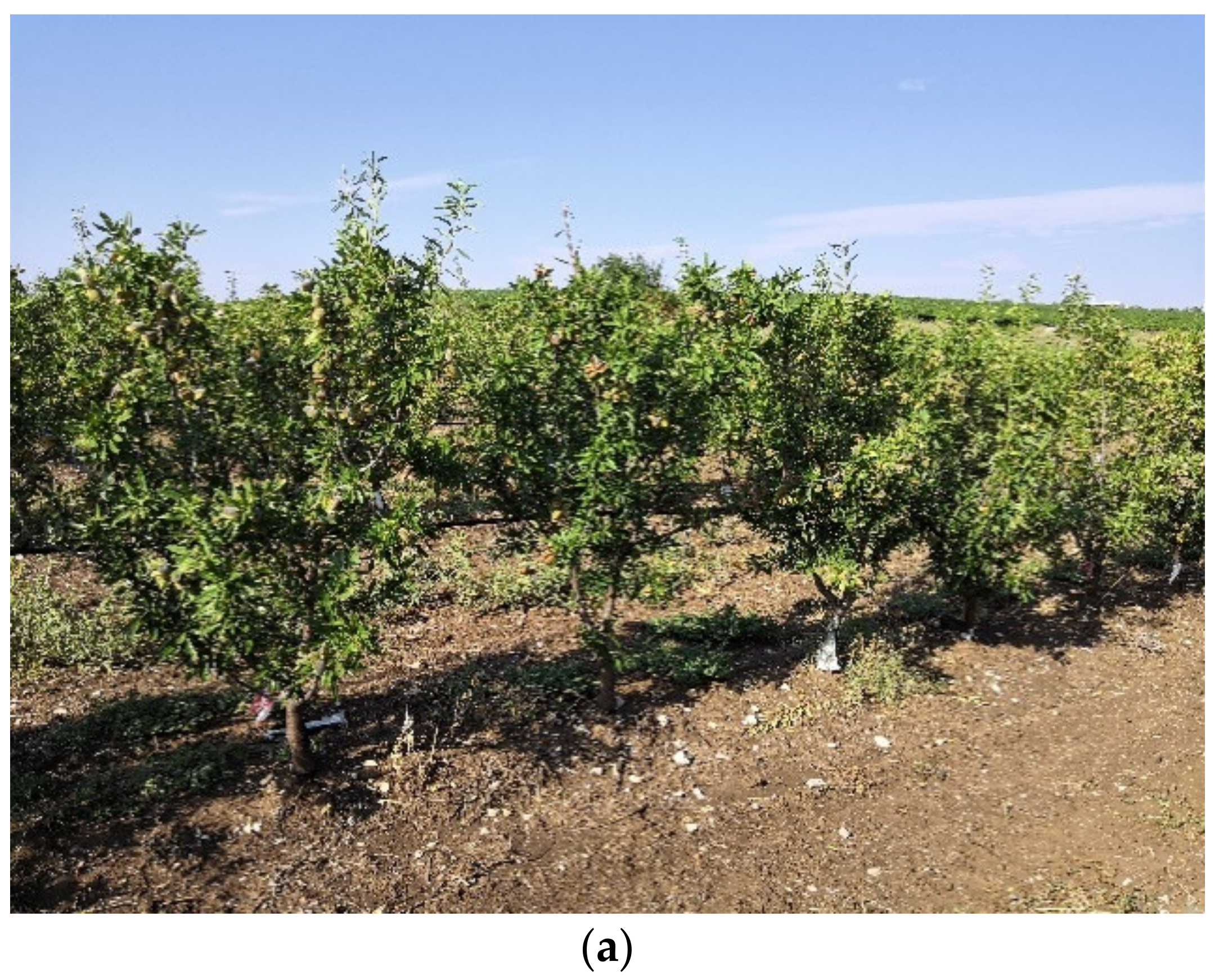
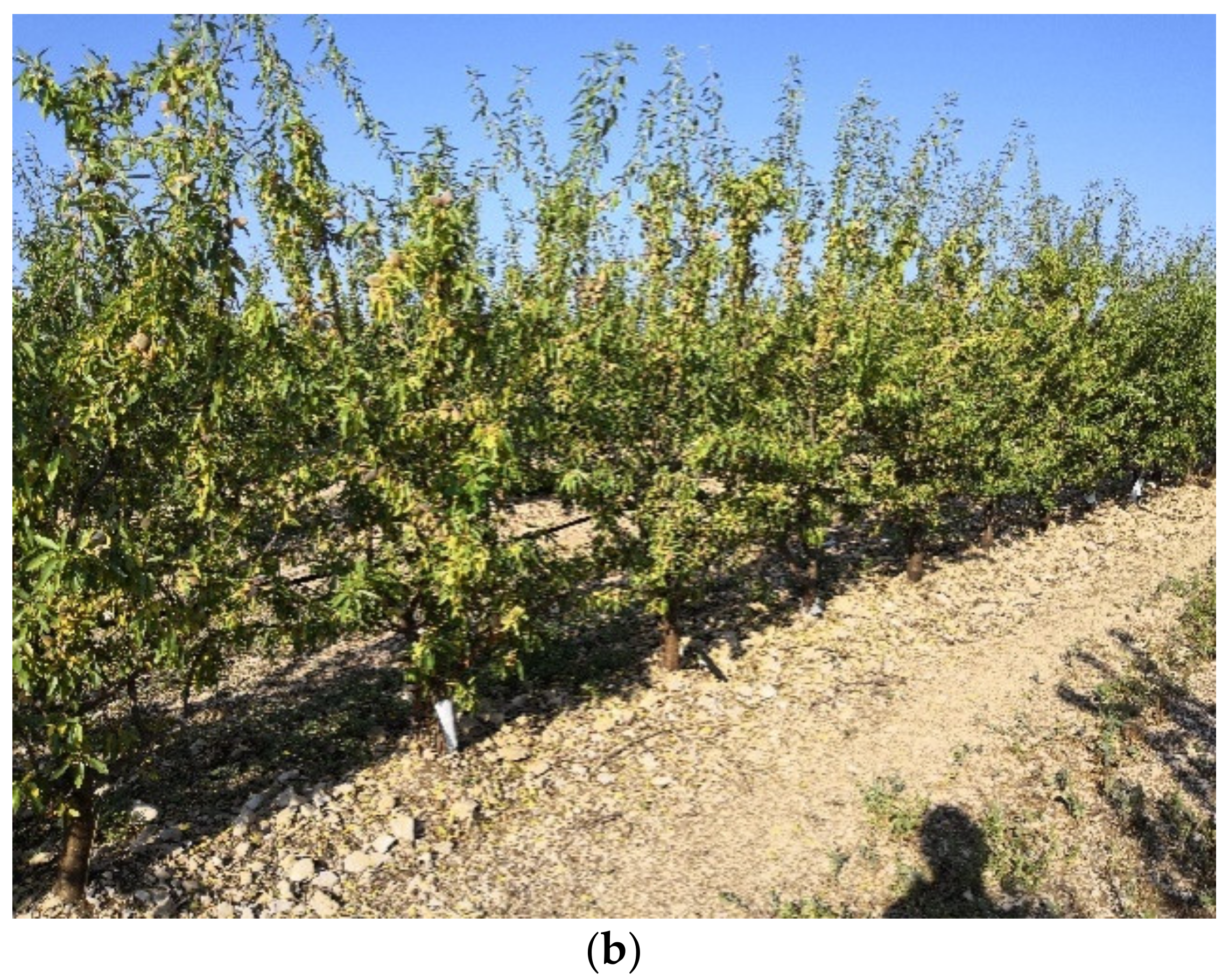

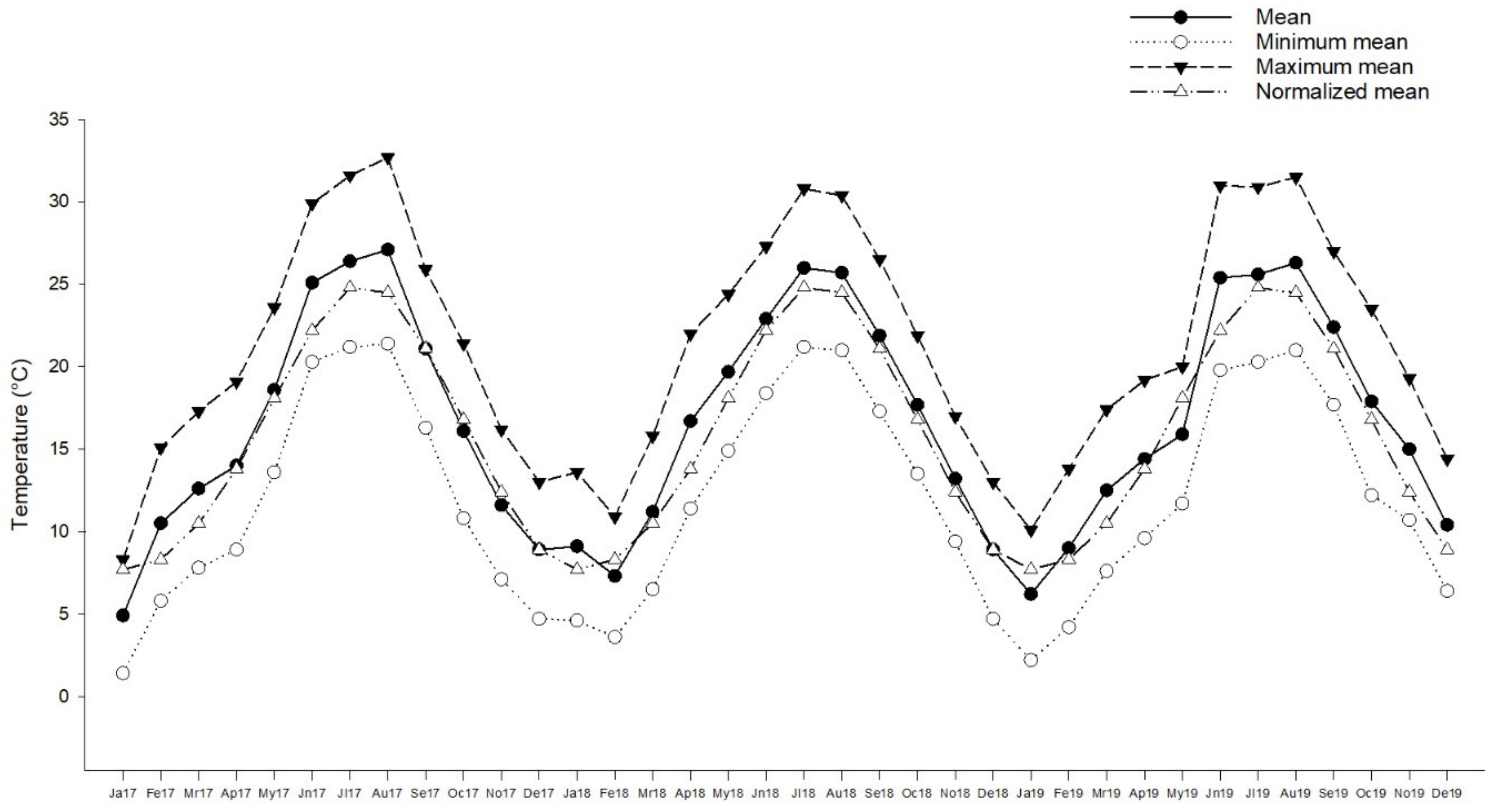
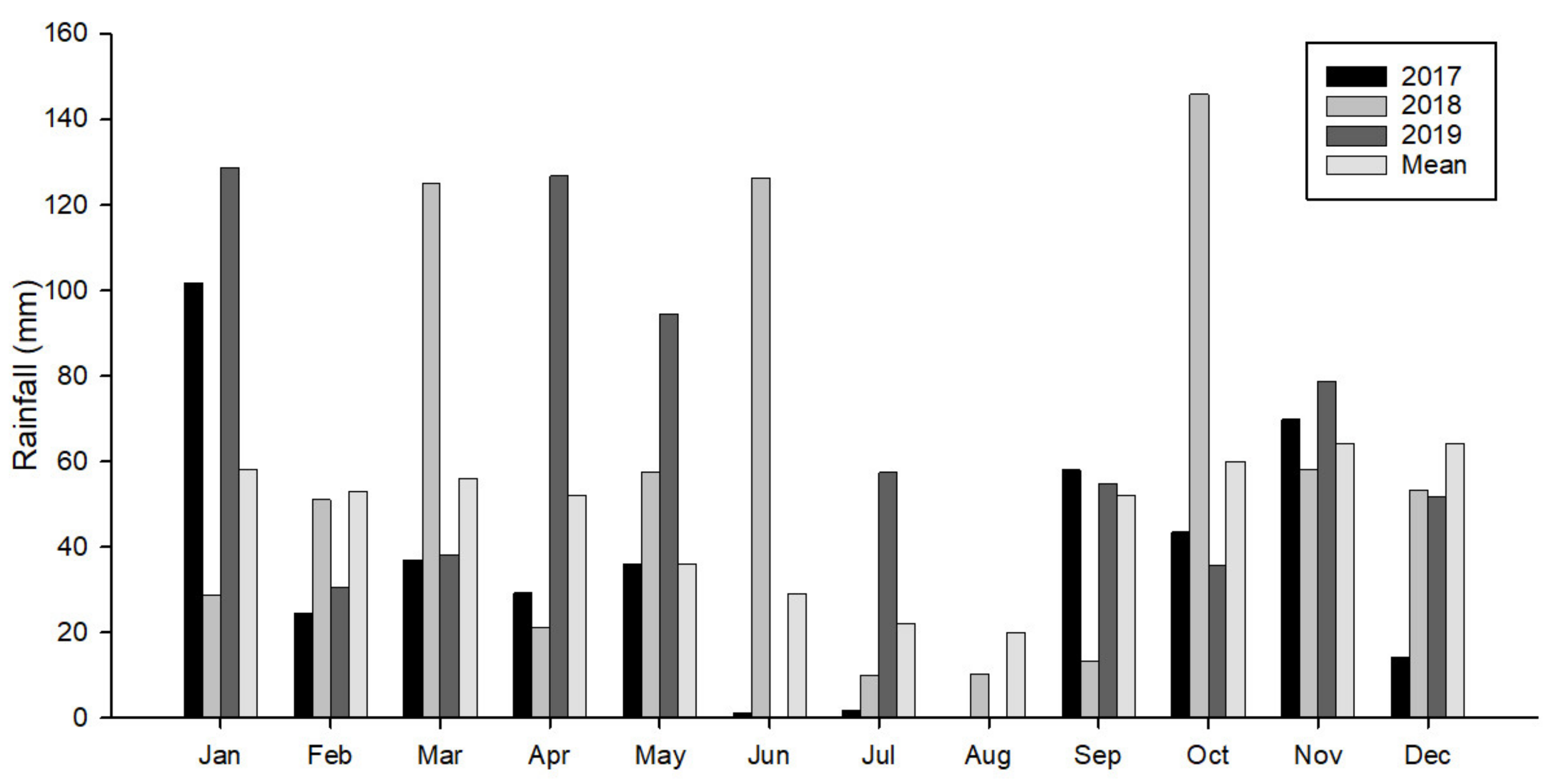
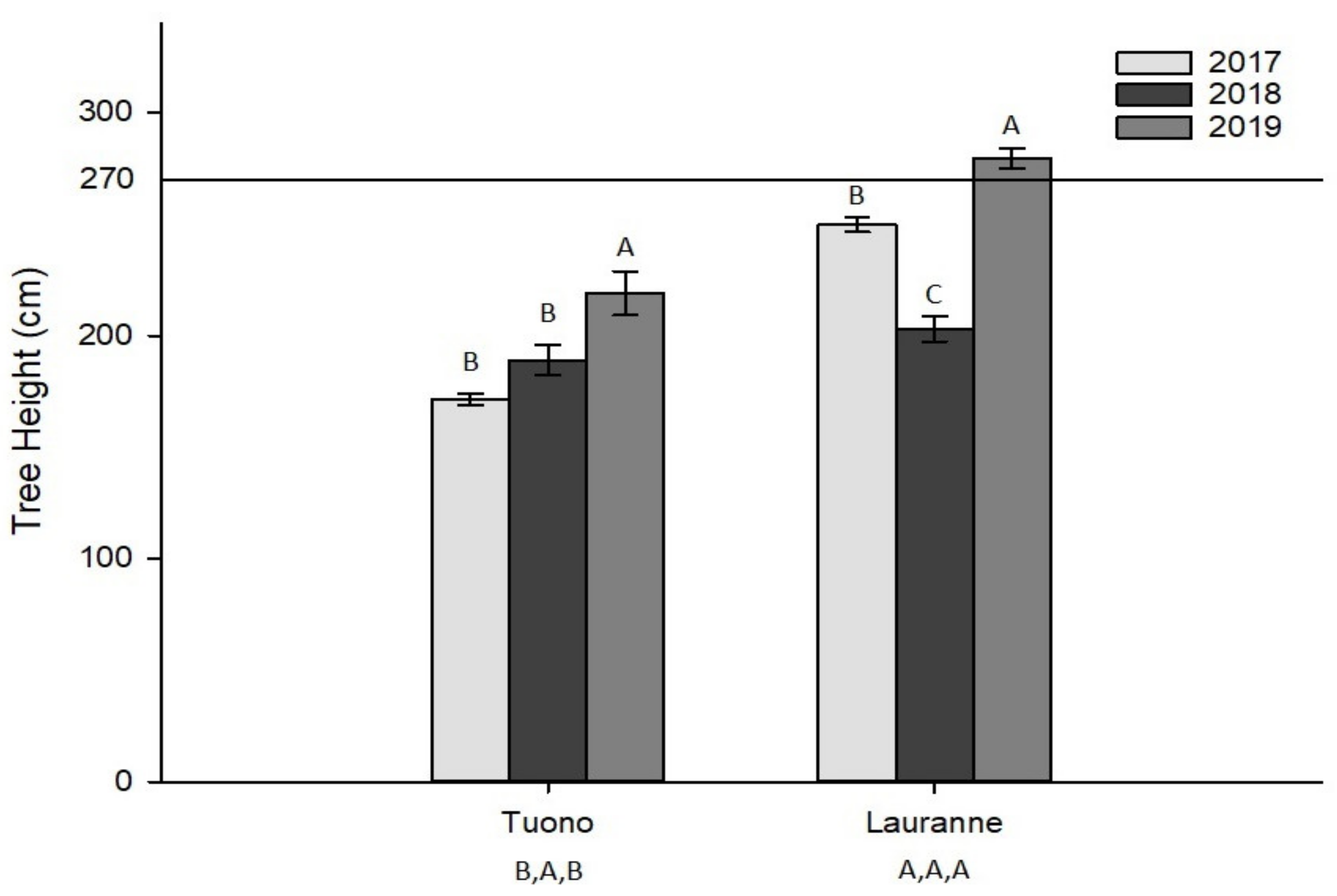
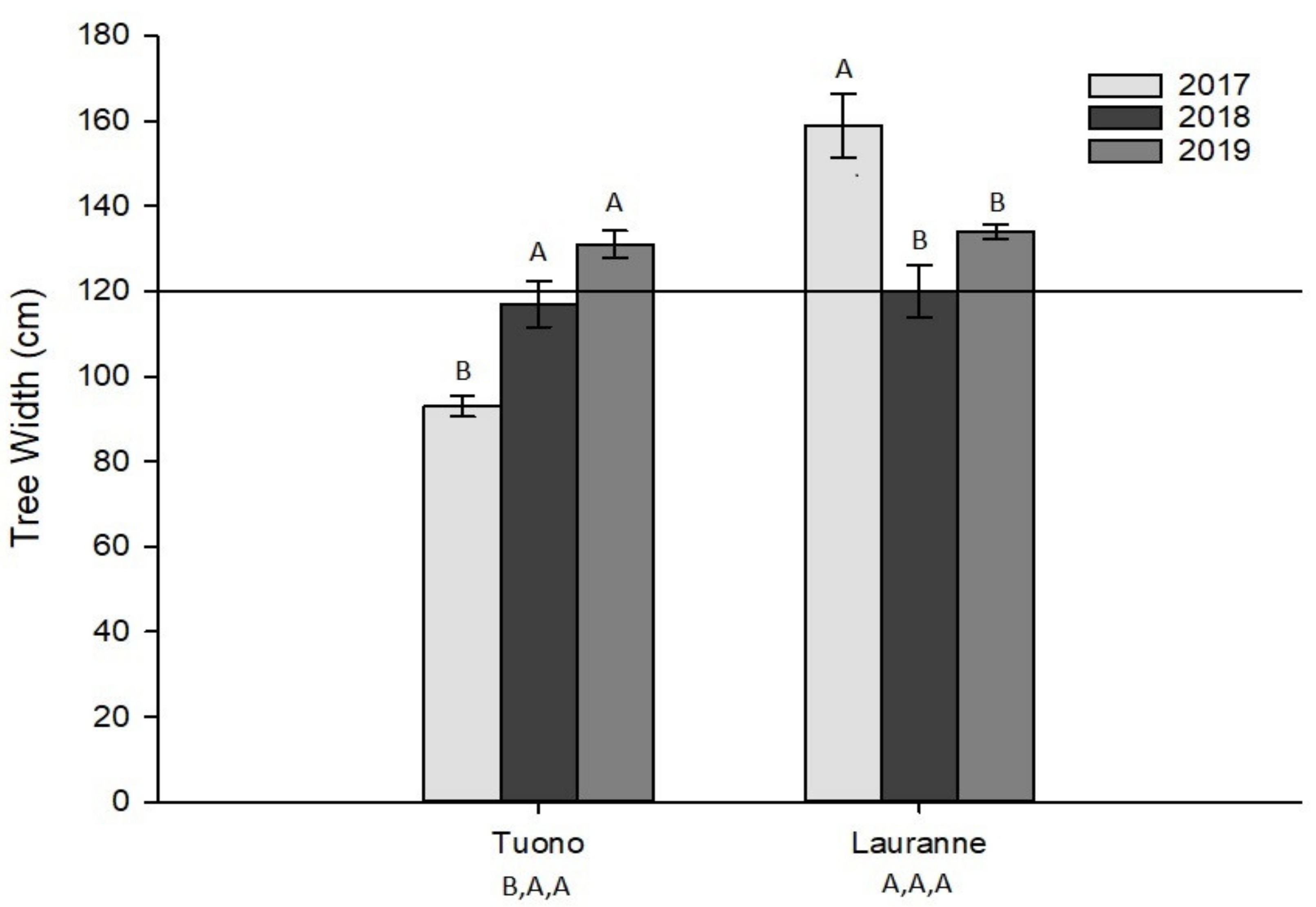

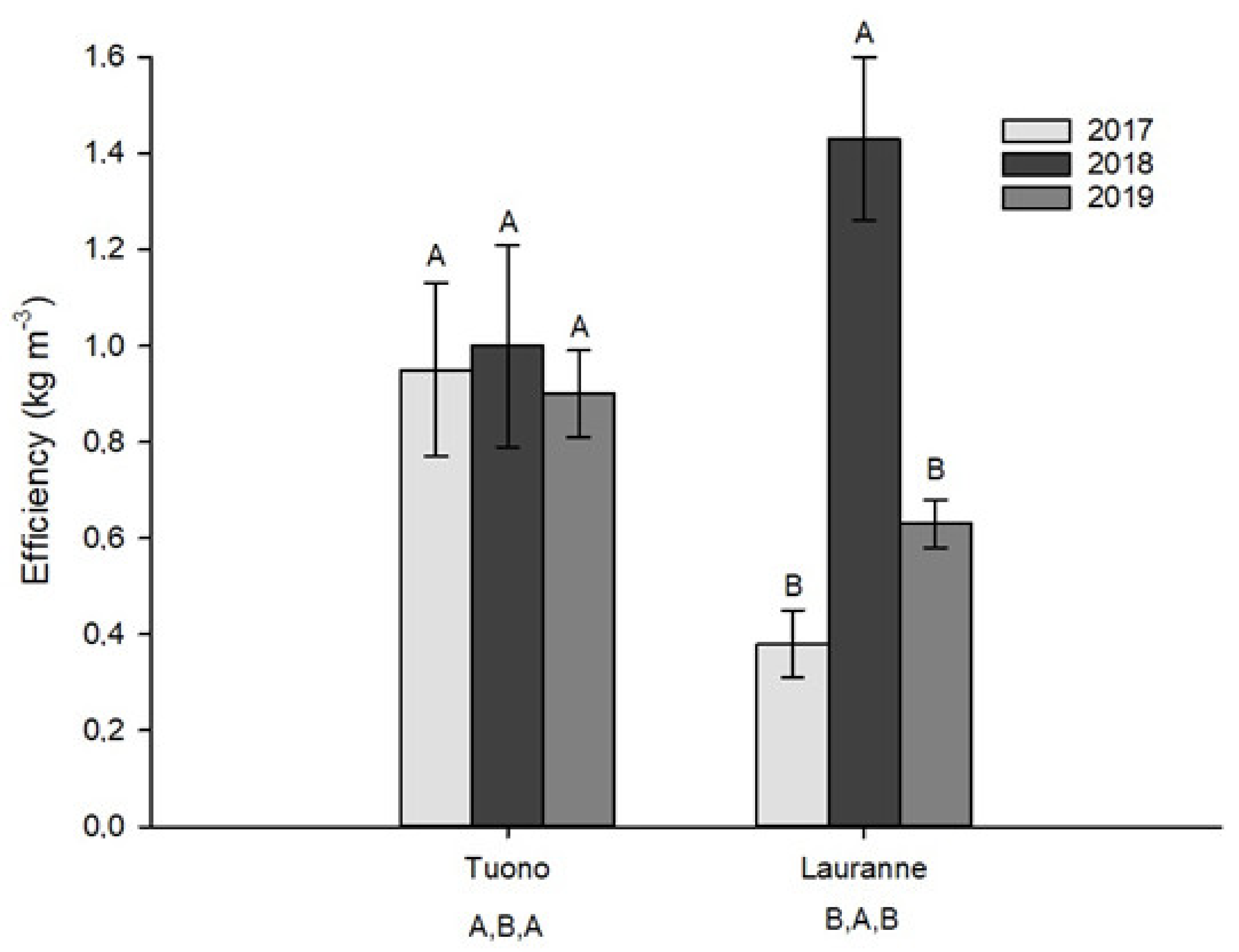
| Parameters | Tuono | Lauranne | ||||||
|---|---|---|---|---|---|---|---|---|
| 2017 | 2018 | 2019 | Mean | 2017 | 2018 | 2019 | Mean | |
| Fruit Yield (kg tree−1) | 1.44 A,B | 2.22 b,A | 2.41 A,A | 2.02 b | 1.52 A,B | 3.45 a,A | 2.46 A,AB | 2.47 a |
| Fruit Yield (t ha−1) | 3.15 A,B | 4.86 b,A | 5.28 A,A | 4.42 b | 3.33 A,B | 7.56 a,A | 5.39 A,AB | 5.41 a |
| Trunk Section (cm2) | 16.3 b,B | 26.6 b,A | 28.3 B,A | - | 24.5 a,B | 32.5 a,B | 41.6 A,A | - |
| Canopy Volume (m3) | 1.46 B,C | 2.12 A,B | 2.81 B,A | 2.13 B | 4.0 A,A | 2.36 A,B | 3.85 A,A | 3.41 A |
| Parameters | Tuono | Lauranne | ||||||
|---|---|---|---|---|---|---|---|---|
| 2017 | 2018 | 2019 | Mean | 2017 | 2018 | 2019 | Mean | |
| Harvested Fruits (%) | 94.3 A,A | 97.6 A,A | 71.1 B,B | 87.6 A | 94.1 A,A | 95.1 A,A | 85.4 A,B | 91.5 A |
| Damaged Axes (%) | 3.33 B,B | 5.98 A,A | 6.73 b,A | 5.35 b | 6.74 A,b | 5.06 A,b | 9.06 a,a | 6.94a |
| Parameters | Tuono | Lauranne | ||||||
|---|---|---|---|---|---|---|---|---|
| 2017 | 2018 | 2019 | Mean | 2017 | 2018 | 2019 | Mean | |
| Shelling (%) | 35.8 A,A | 34.9 A,A | 36.3 A,A | 35.7 A | 36.7 A,A | 40.7 A,A | 37.2 A,A | 38.2 A |
| Hull-Tight Nuts (%) | 0.33 A,A | 1.00 A,A | 2.00 B,A | 1.11 B | 1.67 A,B | 1.33 A,B | 10.0 A,A | 4.33 A |
| Double Seeds (%) | 16.0 A,A | 15.0 A,A | 13.0 A,A | 14.7 A | 0.33 B,B | 0.0 B,B | 6.67 B,A | 2.33 B |
Publisher’s Note: MDPI stays neutral with regard to jurisdictional claims in published maps and institutional affiliations. |
© 2021 by the authors. Licensee MDPI, Basel, Switzerland. This article is an open access article distributed under the terms and conditions of the Creative Commons Attribution (CC BY) license (https://creativecommons.org/licenses/by/4.0/).
Share and Cite
Maldera, F.; Vivaldi, G.A.; Iglesias-Castellarnau, I.; Camposeo, S. Two Almond Cultivars Trained in a Super-High Density Orchard Show Different Growth, Yield Efficiencies and Damages by Mechanical Harvesting. Agronomy 2021, 11, 1406. https://doi.org/10.3390/agronomy11071406
Maldera F, Vivaldi GA, Iglesias-Castellarnau I, Camposeo S. Two Almond Cultivars Trained in a Super-High Density Orchard Show Different Growth, Yield Efficiencies and Damages by Mechanical Harvesting. Agronomy. 2021; 11(7):1406. https://doi.org/10.3390/agronomy11071406
Chicago/Turabian StyleMaldera, Francesco, Gaetano Alessandro Vivaldi, Ignasi Iglesias-Castellarnau, and Salvatore Camposeo. 2021. "Two Almond Cultivars Trained in a Super-High Density Orchard Show Different Growth, Yield Efficiencies and Damages by Mechanical Harvesting" Agronomy 11, no. 7: 1406. https://doi.org/10.3390/agronomy11071406
APA StyleMaldera, F., Vivaldi, G. A., Iglesias-Castellarnau, I., & Camposeo, S. (2021). Two Almond Cultivars Trained in a Super-High Density Orchard Show Different Growth, Yield Efficiencies and Damages by Mechanical Harvesting. Agronomy, 11(7), 1406. https://doi.org/10.3390/agronomy11071406







